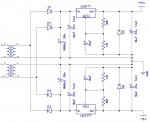donrecardo
Senior Member
Hi , I know its not stictly a Picaxe question but can someone help me out.
I am making a power supply to give ...
-5v 0 +5v
-9v 0 +9v
-12v 0 +12v
-15v 0 +15v
I know I could do it with a pair of positive and negative adjustable regulators but I dont want the hassle of having to try to adjust the voltages to be equal , nor the worry of accidently bumping the adjustment knob and suddenly sending 25 volts or so into an op amp that can only take 15volts.
Plus I might want both +/-15 and +/-5 at the same time
I figured my easiest answer as I already have a toroidal transformer with 2 X 18v secondaries was to .....
Join the secondaries to give me a ground line and to full wave rectify the two ends of the secondaries figuring it will give me around +/-25v. ( 18v X 1.414)
Now on to this +/-25v bus hang both positive and negative 3 pin regulators in
5v, 9v, 12v, and 15v flavours
I found a circuit online showing this done with a pair of Pos and Neg 12v regulators which hopefully I can attach the pic to this post , as I have some questions about it
In the diagram, what do diodes D5 and D6 do and are they neccesary.
I can see that C3 and C4 are a good idea to put on the output of every pair of regulators that I use but do I need C1 and C2 on the input of every pair of regulators too or is it enough to just have C1 and C2 on the output of the bridge rectifier and share them between all the regulators ?
Lastly, am I ok to use 4 pairs of regulators on this one transformer/rectifier output ?
BTW I can see that the voltage of some of the Caps in the picture need changing to suit my voltages
Thanks for your help
Don
I am making a power supply to give ...
-5v 0 +5v
-9v 0 +9v
-12v 0 +12v
-15v 0 +15v
I know I could do it with a pair of positive and negative adjustable regulators but I dont want the hassle of having to try to adjust the voltages to be equal , nor the worry of accidently bumping the adjustment knob and suddenly sending 25 volts or so into an op amp that can only take 15volts.
Plus I might want both +/-15 and +/-5 at the same time
I figured my easiest answer as I already have a toroidal transformer with 2 X 18v secondaries was to .....
Join the secondaries to give me a ground line and to full wave rectify the two ends of the secondaries figuring it will give me around +/-25v. ( 18v X 1.414)
Now on to this +/-25v bus hang both positive and negative 3 pin regulators in
5v, 9v, 12v, and 15v flavours
I found a circuit online showing this done with a pair of Pos and Neg 12v regulators which hopefully I can attach the pic to this post , as I have some questions about it
In the diagram, what do diodes D5 and D6 do and are they neccesary.
I can see that C3 and C4 are a good idea to put on the output of every pair of regulators that I use but do I need C1 and C2 on the input of every pair of regulators too or is it enough to just have C1 and C2 on the output of the bridge rectifier and share them between all the regulators ?
Lastly, am I ok to use 4 pairs of regulators on this one transformer/rectifier output ?
BTW I can see that the voltage of some of the Caps in the picture need changing to suit my voltages
Thanks for your help
Don
Attachments
-
121.9 KB Views: 59



